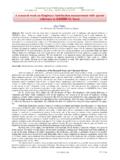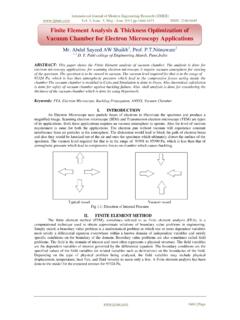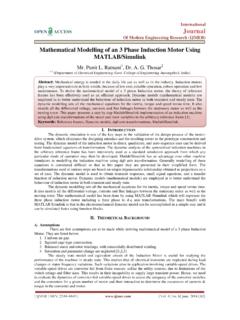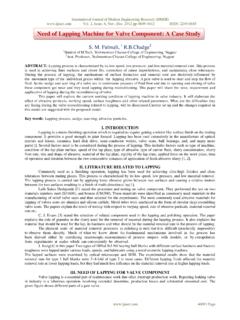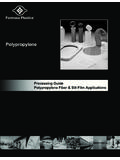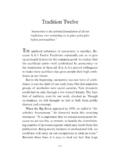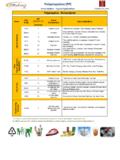Transcription of Effect of Processing Parameters on Polypropylene …
1 International Journal of Modern Engineering Research (IJMER) , , 2012 pp-3056-3060 ISSN: 2249-6645 3056 | Page Ikilem Gocek1, Sabit Adanur2 1(Department of Textile Engineering, Istanbul Technical University, Turkey) 2(Department of Polymer and Fiber Engineering, Auburn University, USA) Abstract- Thin mono-layer Polypropylene (PP) films were produced to study the effects of Processing Parameters .
2 Main difference in the crystalline structure of the PP films is considered to be caused by the orientation of the crystal blocks. As the temperature increases, film thickness decreases. Screw motor speed (SMS) increase results in increase of film thickness. Increase of winding speed (WS) causes the films to be stretched, making them thinner. As the temperature increases, tear strength of the films increases in MD but decreases in CD.
3 Tear strength increases in CD with increasing SMS. As WS increases, tear strength in MD decreases. As the temperature increases, tensile strength increases in MD. When SMS increases, molecular orientation increases in MD causing tensile strength of the films to increase. Tensile strength decreases with increasing SMS in CD. Increase in WS causes tensile strength of the films to increase in MD and decrease in CD. Keywords - Burst strength, Polypropylene cast film, tear strength, tensile strength, winding speed I.
4 INTRODUCTION Polypropylene (PP) finds various new uses in commercial film applications according to its product properties such as thickness, resistance to tear, tensile and burst, transparency, clarity, gloss and haze. Since PP has high tensile strength and elongation at break, low permeability and good chemical resistance as well as low price, it has been used in various packaging and other specialty applications [1]. The characteristics of cast PP films show differences not only due to their chemical structures and the additives and resin modifiers added but also due to their Processing Parameters in extrusion process.
5 Therefore, determining the Effect of Processing Parameters and process conditions in cast film extrusion is important to obtain the exact properties of the films for their end uses. Cast film technology is the simplest technology to produce polymeric films in which the molten polymer is extruded through a slot die, fed by a single-screw extruder, onto a chilled roll in order to be cooled. Then, the solidified film is taken up from the chilled roll by a nip roll (take up roll) and transferred to a winding unit after the edges are trimmed.
6 A limited amount of orientation is obtained in the film by this process; the orientation can be affected by the ratio between the die thickness and film thickness and by the ratio between the extrusion speed and the take up speed. Since the orientation can be easily determined in this method, cast film technology is a low cost and easy-to-handle process. Temperature, screw motor speed and winding speed are the Processing Parameters that have Effect on cast films.
7 The final molecular orientation in a product depends on the thermomechanical history (melt temperature, stress, strain) of the product during processes [2]. It was reported that lower die temperature reduces the mobility of the chains to be extended at high draw ratios at the die exit [3]. Increasing screw motor speed results in the shear rate increase. At a given melt temperature, the higher the shear rate the higher the shear stress, which results in more molecular orientation in a product [2].
8 The aim of this study is to determine the effects of Processing Parameters such as temperature, screw motor speed and winding speed on the physical and structural characteristics and mechanical performance of unmodified and pure PP cast films such as thickness, crystallinity, tear strength, tensile strength and burst strength. II. EXPERIMENTAL Materials and Equipments Used Polypropylene pellets commercially named as 30 Melt Copolymer Natural with a density of g/cm3 and an MFI of 34 g/10 min were bought from Premier Plastic Resins Company.
9 No modifiers and additives were added while producing the PP cast films. Wayne single screw extrusion machine having a cm cast film die was used to produce Polypropylene (PP) cast films in combination with a chill roll and a nip (take up) roll. The die melt was quenched onto a chill roll. The film was taken up through a pair of nip rolls onto a winder. For tensile testing, Instron 5565 universal testing machine was used, which has 5 kN capacity and mm/min speed range.
10 Thickness measurements were done using Testing Machines Inc., (TMI) micrometer. Crystallinity tests were performed on all film samples using a TA Instruments DSC Q-2000 differential scanning calorimetry (DSC). Manufacturing and Testing Twelve PP films were produced by using cast film technology. The machine Parameters such as temperature, screw speed and winding speed were changed during production to observe their effects on film final properties. The machine Parameters that were changed during the manufacturing process can be seen in Table 1.
